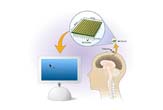
Using a novel brain-computer interface, a man paralyzed from the neck down was able to move a cursor on a computer screen, play "neural Pong" and control a robotic arm using only his thoughts.
The achievement, reported by LiveScience last year and detailed in the July 13 issue of the journal Nature, could provide new hope to people with paralysis.
"The results hold promise to one day be able to activate limb muscles with these brain signals, effectively restoring brain-to-muscle control via a physical nervous system," said study leader John Donoghue, a professor and director of the brain science program at Brown University.
Donoghue is also the chief scientist at Cyberkinetics Neurotechnology Systems Inc., the company that created the device.
How it works
Called BrainGate, the so-called "neuromotor prosthesis" consists of a surgically implanted sensor that records the activity of dozens of brain cells simultaneously. The sensor is square and about the size of a baby aspirin; it has 100 tiny electrodes, each thinner than a human hair.
The sensor is implanted on the surface of the patient's motor cortex, the region of the brain responsible for voluntary movement.
Get the world’s most fascinating discoveries delivered straight to your inbox.
The electrodes, which penetrate about 1 millimeter into the surface of the brain, pick up electrical signals from nearby neurons. These signals are transmitted to a computer via thin gold wires, where they are decoded in real time and used to control electronic equipment.
The researchers originally tested their system on monkeys before moving to clinical trials in humans.
Thought control
The first BrainGate trial patient was Matthew Nagle, a 25-year-old man who had been paralyzed from the neck down since 2001 due to spinal cord injury. Using the device, Nagle was able to perform simple tasks such as moving a cursor to a target on a computer screen, open simulated e-mail, draw circular shapes using a paint program and play neural Pong, a simple video game, by simply thinking about the tasks. He also controlled a robotic arm to pick up pieces of hard candy and drop them into a technician's hand.
"When asked to 'think right' or 'think left,' patients were able to change their neural activity immediately," Donoghue said. "And their use of the device is seemingly easy. Patients can control the computer cursor and carry on a conversation at the same time, just as we can simultaneously talk and use our computers."
Nagle used the device for nine months, until a decline in neural signals forced the trial to be halted.
In 2005, the device was implanted into the brain of a second patient, a 55-year-old man who also had spinal cord injury. After training, he was able to control the cursor for three months before a technical issue caused signal loss at most of the electrodes.
During training, patients are asked to imagine moving one hand as if they were controlling the computer mouse. BrainGate then translates the patterns of neural spikes into two-dimensional commands.
"Training patients to move things with their minds is different with each patient," said Maryam Saleh, who worked with the first two patients as a Cyberkinetics technician.
Still a ways to go
The researchers say that there is still a lot of work to do on their device before it can become publicly available.
The current incarnation of BrainGate is bulky and cumbersome and the quality of the signal can vary from patient to patient and from day to day. Also, the second patient never developed as much control as Nagle, and even Nagle's level of control is still "considerably less than that of an able-bodied person using a manually controlled computer cursor," the researchers write.
The researchers plan to include faster and more precise algorithms to speed up processing of the neuronal signals and to also make the BrainGate wireless and more portable.


